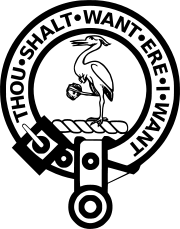
Clan Cranstoun
Encyclopedia

Scottish clan
Scottish clans , give a sense of identity and shared descent to people in Scotland and to their relations throughout the world, with a formal structure of Clan Chiefs recognised by the court of the Lord Lyon, King of Arms which acts as an authority concerning matters of heraldry and Coat of Arms...
.
Origins of the clan
The name Cranstoun comes from the Barony of Cranstoun in MidlothianMidlothian
Midlothian is one of the 32 council areas of Scotland, and a lieutenancy area. It borders the Scottish Borders, East Lothian and the City of Edinburgh council areas....
. The family owned lands in the counties of Edinburgh
Edinburgh
Edinburgh is the capital city of Scotland, the second largest city in Scotland, and the eighth most populous in the United Kingdom. The City of Edinburgh Council governs one of Scotland's 32 local government council areas. The council area includes urban Edinburgh and a rural area...
and Roxburgh
Roxburgh
Roxburgh , also known as Rosbroch, is a village, civil parish and now-destroyed royal burgh. It was an important trading burgh in High Medieval to early modern Scotland...
.
The first known person of the Cranstoun family was Elfric de Cranstoun who was a witness to a charter by William the Lion in Holyrood
Holyrood, Edinburgh
Holyrood is an area in Edinburgh, the capital of Scotland. Lying east of the city centre, at the end of the Royal Mile, Holyrood was once in the separate burgh of Canongate before the expansion of Edinburgh in 1856...
in about 1170. Around that time he also appears in a deed between Robert de Quincy and the Abbot of Newbattle.
.png)
16th century
The Cranstouns of that Ilk prospered until they became mixed up in the unstable political situation of 1592. Thomas and John Cranston were amongst those accused of treason for assisting the Earl of BothwellEarl of Bothwell
The title Earl of Bothwell has been created twice in the Peerage of Scotland. It was first created for Patrick Hepburn in 1488, and was forfeited in 1567. It was then created for Francis Stewart in 1587...
in his attack on the palace of Holyrood House.
The Cranstoun family are known to have lived up to their motto ""thou shalt want before I want" as they are known to have often taken part in the border clan raids of England.
17th century & Civil War
The Clan Cranstoun took the side of the Royalists during the Civil War. The clan was led by chief, third Lord Cranston at the Battle of WorcesterBattle of Worcester
The Battle of Worcester took place on 3 September 1651 at Worcester, England and was the final battle of the English Civil War. Oliver Cromwell and the Parliamentarians defeated the Royalist, predominantly Scottish, forces of King Charles II...
in 1651 where he was captured. He languished in the Tower of London
Tower of London
Her Majesty's Royal Palace and Fortress, more commonly known as the Tower of London, is a historic castle on the north bank of the River Thames in central London, England. It lies within the London Borough of Tower Hamlets, separated from the eastern edge of the City of London by the open space...
. All of his estates were forfeited apart from a small amount that were left for his family and children.
Two governors of Rhode Island, John Cranston (politician) who was a first settler (born in Edinburgh, Scotland), and his son Samuel Cranston
Samuel Cranston
Samuel Cranston was a governor of the Colony of Rhode Island and Providence Plantations during the first quarter of the 18th century. He held office from 1698 to 1727, being elected to office 30 times , and served as governor longer than any other individual in the history of both the colony and...
were of the clan.
Napoleonic Wars
James, eighth Lord Cranstoun, was a distinguished officer in the Royal Navy who commanded HMS BellerophonHMS Bellerophon (1786)
The first HMS Bellerophon of the Royal Navy was a 74-gun third-rate ship of the line launched on 6 October 1786 at Frindsbury on the River Medway, near Chatham. She was built at the shipyard of Edward Greaves to the specifications of the Arrogant, designed by Sir Thomas Slade in 1758, the lead ship...
in a squadron of only seven ships which was attacked on 17 June 1795 by a French fleet three times larger. After a running battle which lasted more than twelve hours, the French were completely defeated, and eight ships of the line were destroyed. Lord Cranstoun was later appointed Governor of Grenada, but before he could set foot upon the island, he died, it is believed of lead poisoning, in 1796. The peerage became extinct in 1813.

